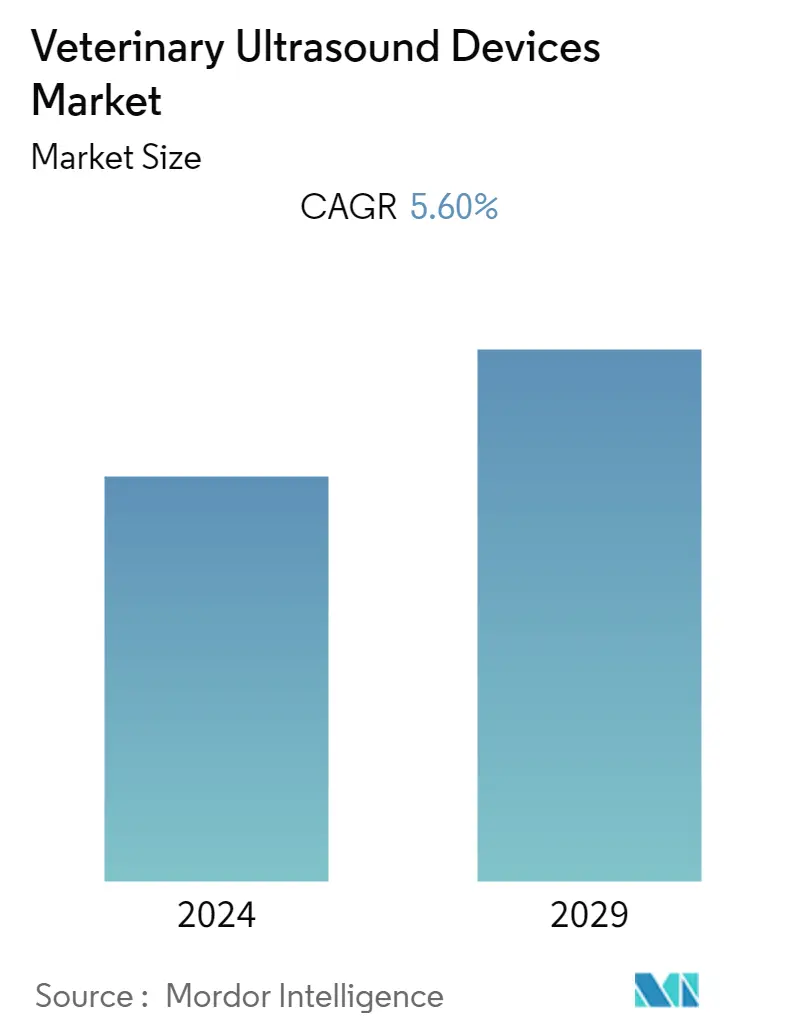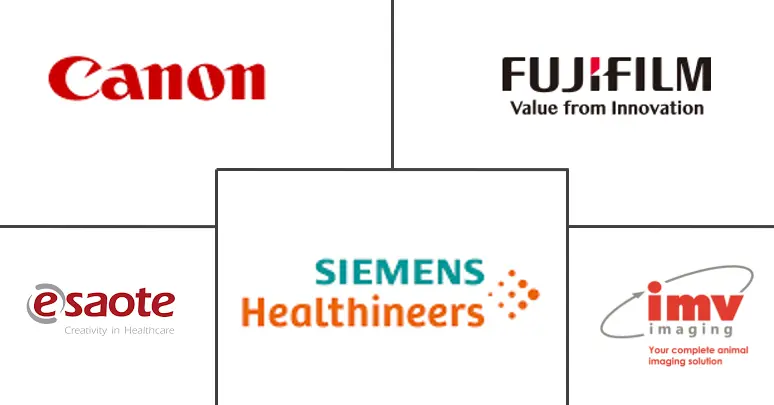
| Study Period | 2021 - 2029 |
| Base Year For Estimation | 2023 |
| Forecast Data Period | 2024 - 2029 |
| Historical Data Period | 2021 - 2022 |
| CAGR | 5.60 % |
| Fastest Growing Market | Asia-Pacific |
| Largest Market | North America |
Major Players
*Disclaimer: Major Players sorted in no particular order |
Veterinary Ultrasound Devices Market Analysis
The veterinary ultrasound devices market is poised to grow at a CAGR of 5.6% over the forecast period.
The COVID-19 pandemic has had a significant influence on total veterinary healthcare, owing mostly to restrictions on non-essential operations or hospital visits. The pandemic resulted in delayed or canceled pet care in several nations, causing some veterinarians to be concerned about pet health. However, veterinarians are attempting to combat this by implementing strict COVID-19 safety measures in their clinics and vastly expanding the use of telemedicine for their patients. The pandemic encouraged pet ownership in several nations, resulting in more animal health care, which raised the demand for veterinary ultrasound imaging. For instance, the ASPCA reported in May 2021 that nearly one in every five households had acquired a cat or dog since the beginning of the COVID-19 crisis. Hence, these adoptions of pets enhanced the focus on pet health and aided the growth of the veterinary ultrasound imaging market.
The market is primarily driven by increasing pet adoption and rising animal expenditures coupled with the rising in the adoption of diagnostics imaging for various diseases. According to the Pet Food Manufacturers Association, as of 2021, 3.2 million households in the United Kingdom had acquired a pet since the outbreak began. In the United Kingdom, there are currently 34 million pets, including 12 million cats, 12 million dogs, 3.2 million small mammals such as guinea pigs and hamsters, 3 million birds, and 1.5 million reptiles. Similarly, as per the report by the AVMA on pet ownership and expenditure in the United States, published in October 2022, the percentage of households that own at least one cat increased between 2020 and 2022, from 26% to 29% it also stated that the mean cost of an annual wellness visit for a dog and a cat was USD 192 and USD 169 in 2022. Thus, an increase in pet adoption is expected to increase the healthcare concerns for the diagnosis of pets coupled with veterinary spending is likely to boost market growth over the forecast period.
According to the study report by Front Vet Sci in August 2022, combining the measurement of renal size by ultrasonography with other ultrasonographic characteristics in cats can yield useful clinical data. Hence, the role of ultrasound plays a key role in the assessment of organ functioning which drives the market over the forecast period. However, the lack of skilled personnel and the high cost of devices restrain the market growth over the forecast period.
Veterinary Ultrasound Devices Industry Segmentation
As per the scope of the report, veterinary ultrasound devices use ultrasonic sound waves in the frequency range of 1.5-15 megahertz (MHz) to create images of internal body structures, based on the pattern of echoes reflected from the targeted organs and tissues.
The Veterinary Ultrasound Devices Market is Segmented by Product (Hand-held (Portable) Ultrasound Scanner and Cart-based Ultrasound Scanner), Animal Type (Small Animals and Large Animals), and Geography (North America, Europe, Asia-Pacific, Middle East & Africa, and South America). The market report also covers the estimated market sizes and trends for 17 different countries across major regions, globally. The report offers the value (in USD million) for the above segments.
| Handheld (Portable) Ultrasound Scanner |
| Cart-based Ultrasound Scanner |
| Small Animals |
| Large Animals |
| North America | United States |
| Canada | |
| Mexico | |
| Europe | Germany |
| United Kingdom | |
| France | |
| Italy | |
| Spain | |
| Rest of Europe | |
| Asia-Pacific | China |
| Japan | |
| India | |
| Australia | |
| South Korea | |
| Rest of Asia-Pacific | |
| Middle East & Africa | GCC |
| South Africa | |
| Rest of Middle East & Africa | |
| South America | Brazil |
| Argentina | |
| Rest of South America |
Veterinary Ultrasound Devices Market Size Summary
The veterinary ultrasound devices market is experiencing a steady growth trajectory, driven by increasing pet adoption and rising expenditures on animal healthcare. The COVID-19 pandemic initially posed challenges by delaying non-essential veterinary services, but it also led to a surge in pet ownership, which subsequently heightened the demand for veterinary ultrasound imaging. This demand is further fueled by the growing need for diagnostic imaging to address various animal health concerns. Technological advancements in ultrasound systems, such as the development of more precise and efficient devices, are also contributing to market expansion. Key players in the industry are continuously innovating and launching advanced ultrasound devices, which enhance imaging quality and support market growth.
In North America, the veterinary ultrasound devices market is poised for significant growth due to high pet ownership rates and increased per capita spending on animal healthcare. The prevalence of animal diseases and internal injuries further drives the demand for diagnostic examinations. The market is moderately competitive, with several companies focusing on expansion strategies and introducing novel products to capture market share, particularly in regions with high pet adoption rates. Partnerships and collaborations among key players are also shaping the market landscape, as seen with companies like Advanced Veterinary Ultrasound and Draminski SA. These dynamics indicate a robust growth potential for the veterinary ultrasound devices market over the forecast period.
Veterinary Ultrasound Devices Market Size - Table of Contents
1. MARKET DYNAMICS
- 1.1 Market Overview
-
1.2 Market Drivers
- 1.2.1 Increase in Animal Adoption and Animal Health Expenditure
- 1.2.2 Rise in Demand for Diagnosis of Animal Health Conditions and Technological Advancements
-
1.3 Market Restraints
- 1.3.1 Lack of Skilled Personnel
- 1.3.2 High Cost of the Devices
-
1.4 Industry Attractiveness - Porter's Five Forces Analysis
- 1.4.1 Threat of New Entrants
- 1.4.2 Bargaining Power of Buyers/Consumers
- 1.4.3 Bargaining Power of Suppliers
- 1.4.4 Threat of Substitute Products
- 1.4.5 Intensity of Competitive Rivalry
2. MARKET SEGMENTATION (Market Size by Value - USD million)
-
2.1 By Product
- 2.1.1 Handheld (Portable) Ultrasound Scanner
- 2.1.2 Cart-based Ultrasound Scanner
-
2.2 By Animal Type
- 2.2.1 Small Animals
- 2.2.2 Large Animals
-
2.3 Geography
- 2.3.1 North America
- 2.3.1.1 United States
- 2.3.1.2 Canada
- 2.3.1.3 Mexico
- 2.3.2 Europe
- 2.3.2.1 Germany
- 2.3.2.2 United Kingdom
- 2.3.2.3 France
- 2.3.2.4 Italy
- 2.3.2.5 Spain
- 2.3.2.6 Rest of Europe
- 2.3.3 Asia-Pacific
- 2.3.3.1 China
- 2.3.3.2 Japan
- 2.3.3.3 India
- 2.3.3.4 Australia
- 2.3.3.5 South Korea
- 2.3.3.6 Rest of Asia-Pacific
- 2.3.4 Middle East & Africa
- 2.3.4.1 GCC
- 2.3.4.2 South Africa
- 2.3.4.3 Rest of Middle East & Africa
- 2.3.5 South America
- 2.3.5.1 Brazil
- 2.3.5.2 Argentina
- 2.3.5.3 Rest of South America
Veterinary Ultrasound Devices Market Research FAQs
What is the current Veterinary Ultrasound Devices Market size?
The Veterinary Ultrasound Devices Market is projected to register a CAGR of 5.6% during the forecast period (2025-2030)
Who are the key players in Veterinary Ultrasound Devices Market?
Esaote SpA, Fujifilm Holdings Corporation, IMV Imaging, Canon Inc. and Siemens Healthcare GmbH are the major companies operating in the Veterinary Ultrasound Devices Market.


